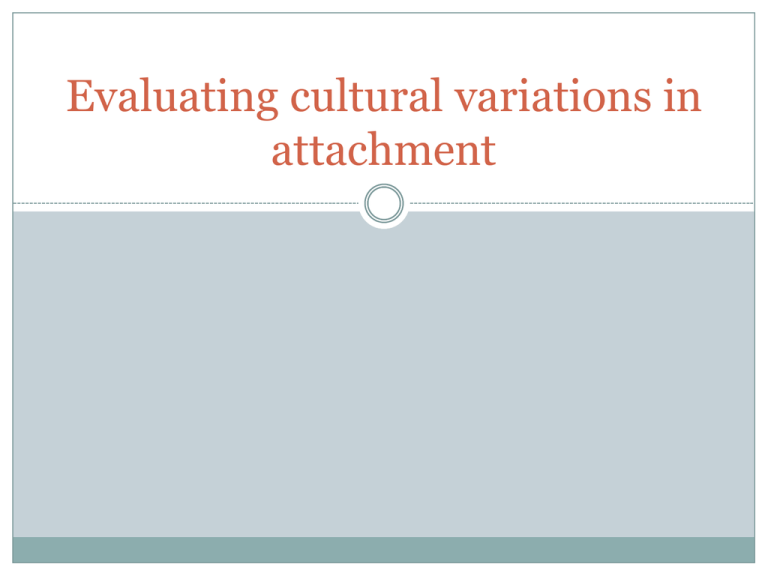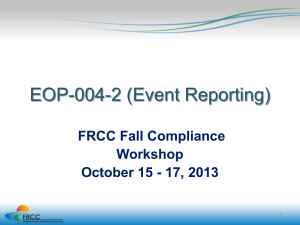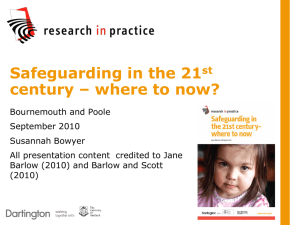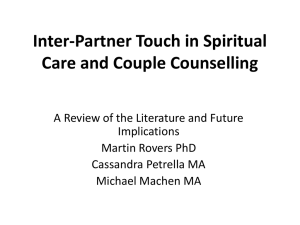Evaluating cultural variations in attachment PP
advertisement

Evaluating cultural variations in attachment Starter activity: True or false? Instructions 1. Write down numbers 1-10 on a piece of paper. 2. Read each statement carefully. 3. Answer each statement with either “true” or “false” 4. If the statement is “false” state why. 5. Two questions will have additional marks for extra details. Good luck! 1. Individualist countries emphasise the importance of the individual. 2. The USA is an example of a collectivist culture. 3. Ainsworth was interested in seeing if there was evidence of inter-cultural differences in attachment between countries. 4. A problem with cross cultural studies in attachment is that the strange situation is culturally biased (extra point for saying what this means)! 5. Fox observed attachment styles in an Israeli kibuttz. 6. A criticism of Fox’s research stated that Fox was accused of Observer Bias. 7. Van Ijzendoorn and Kroonenberg found most infants in Uganda were cared by several adults and so formed multiple attachments. 8. One problem with the study by Van Ijzendoorn and Kroonenberg was that 27 of the studies were carried out on non-western countries and only 5 on western countries. 9. An imposed etic is when behaviour is studied from outside the culture. 10. The strange situation technique can be seen as culturally biased. (Extra point for saying why) Questions (True or false) 1. 2. 3. 4. 5. 6. 7. 8. 9. 10. Individualist countries emphasise the importance of the individual. The USA is an example of a collectivist culture. Ainsworth was interested in seeing if there was evidence of inter-cultural differences in attachment between countries. A problem with cross cultural studies in attachment is that the strange situation is culturally biased (extra point for saying what this means)! Fox observed attachment styles in an Israeli kibutz. A criticism of Fox’s research stated that Fox was accused of Observer Bias. Van Ijzendoorn and Kroonenberg found most infants in Uganda were cared by several adults and so formed multiple attachments. One problem with the study by Van Ijzendoorn and Kroonenberg was that 27 of the studies were carried out on non-western countries and only 5 on western countries. An imposed etic is when behaviour is studied from outside the culture. The strange situation technique can be seen as culturally biased. (Extra point for saying why) Learning objectives To consider important research and to use this research to evaluate cultural variations in attachment. To outline and critically assess the strengths and weaknesses of cultural variations research in attachment. Evaluating cultural variations in attachment Criticisms Criticism 1. Van Ijzendoorn and Kroonenberg (1988) research is non representative and culturally biased. Why? The strange situation may not be a valid measure in all countries as the values in each different culture. (Individualistic vs collectivist cultures) Example: sensitivity in Japan is different from the US Therefore: it is not a valid measure of attachment. Example 1 The sensitivity hypothesis Ainsworth and Bowlby state that secure attachment relies on the caregiver being responsive and sensitive. However Rothbaum et al (2000) argue that they only consider the western view of promoting independence. Whereas in collectivist cultures such as Japan competency is based on being group-oriented. Van Ijzendoorn and Kroonenberg 2. Attachment theory is based on individualist cultures ideas. Therefore research is culturally biased. This is an imposed etic (the use of a technique designed in one culture but imposed on another) as Van Ijzendoorn and Kroonenberg looked at several studies of attachment behaviour which had been studied from outside the culture. We cannot make assumptions about other cultures. Example 2. The Continuity hypothesis. Ainsworth and Bowlby believe secure attachment leads to more social and emotional competency. However Rothbaum et al (2002) suggest that the view of competency is biased as it is about independence. In Japan competency is based on being group oriented. Exam question Explain one criticism of investigating cultural variations in attachment using the “strange situation” (3 marks) Exemplar answers: three mark answer Van Ijzendoorn and Kroonenberg’s findings for evidence of inter-cultural differences in attachment between countries came from 18 different studies. (Mark 1 for identifying a criticism) We can’t be sure that all of the studies were carried out in the same way. (2 mark for elaboration) It is possible that the “strange situation” or ways of categorising types of attachment were different in the different studies. One mark answer One criticism of investigating cultural variations in attachment using the “strange situation” is that you can’t apply this for all countries.- 1 Mark No explanation of the criticism No elaboration Peer marking activity Read your participants answer and: 1. 2. 3. 4. 5. Highlight the key words in the question. Highlight the key psychological words in each answer. Underline the key evaluation point. Using the mark scheme provided, score their answer out of 3. Justify each mark given and state how you may improve the answer. Task In pairs, look back at your notes of the strange situation. Identify two strengths of the strange situation as a way of measuring attachment. Using your notes of Fox (1977) and Van Ijzendoorn and Kroonenberg (1988) write these two strengths from the strange situation. Consider how you would apply these strengths when answering a question on cultural variations in attachment (you will need this for the next task). Essay plan. “Outline and evaluate research into cultural variations in attachment”- 12 marks. Write an essay plan of how you would answer this question. Look at the essay plan grid on the board for help. Remember you should include both AO1 and AO2 in your answers. Working independently. You have 15 minutes to do this. These will be taken in at the end of the lesson. H0mework Make revision notes for cultural variations into attachments. These will be taken in at the beginning of next lesson. Plenary activity: stand up sit down activity 1. 2. 3. 4. 5. 6. 7. 8. 9. 10. 11. 12. 13. 14. 15. ……………believe secure attachment leads to more social and emotional competency. (Ainsworth and Bowlby) Collectivist cultures focus on the importance of the ……… (group) A weakness of Van Ijzendoorm and Kroonenberg was that …… The sensitivity hypothesis states that…….. What does culturally biased mean? What is an “imposed etic”? What is an example of a collectivist culture? What is a criticism of Fox’s research? What is the most common found attachment type across all studies? Who looked at an Israeli Kibbutz? What is the continuity hypothesis? How many criticisms should you give for a 3 mark question? Give me 1 mark you would get for a 3 mark evaluation qu. Give a second/third mark example? Give a strength of the strange situation?







